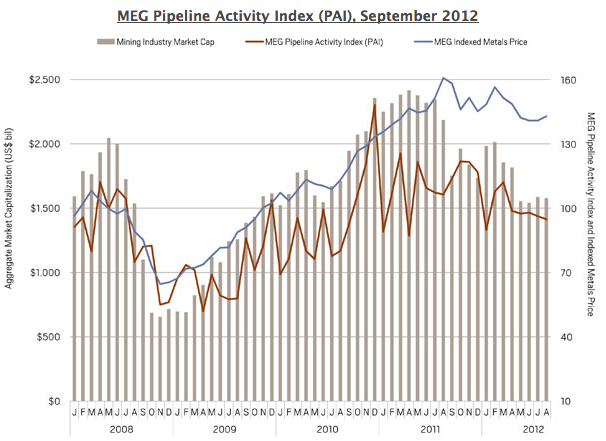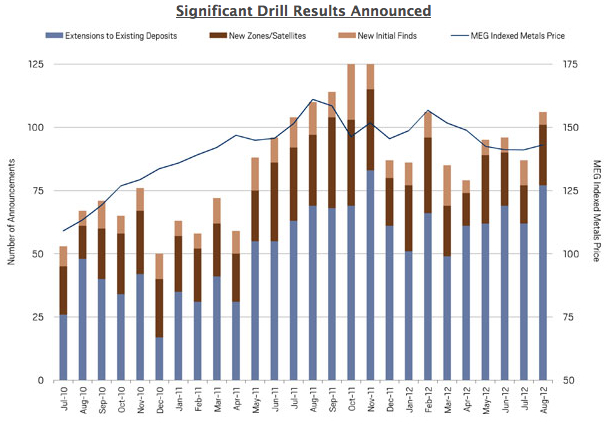Overall activity in the supply pipeline declined only slightly in July and August, said Thursday Halifax-based Metals Economics Group (MEG), as downward pressure due to ongoing financing difficulties was again mitigated by strong numbers of initial resource announcements and drilling activity.
Explorers —said the group— are coping by focusing on priority targets and avoiding wasteful spending, which so far has helped the overall junior sector evade large-scale slashing of exploration spending. However, at some point in the near term financing conditions will need to improve or junior exploration spending will inevitably suffer.
The mining industry’s aggregate market cap appears to have settled since plunging in May, but the September quarter earnings reports will likely be the next key test of investor confidence in the industry. The aggregate market cap has been below $2 trillion for six consecutive months—the longest stretch since mid-2010.
 As is the case for most of 2012 to date, financing conditions remain difficult. Although the number of significant financings (US$2 million minimum) was slightly better in August than in July, the 96 financings completed in July and August combined is the lowest two-month total since 2009 and the $1.32 billion raised is the lowest two-month total since 2008. While many intermediates and more prominent juniors have been able to raise some funds through traditional or alternative sources, the amounts are typically much less than would be expected in a more favorable environment. Many junior explorers continue to report on active exploration programs and have sufficient cash on hand to carry them through; however, financing conditions will need to improve or junior exploration activity will eventually slow.
As is the case for most of 2012 to date, financing conditions remain difficult. Although the number of significant financings (US$2 million minimum) was slightly better in August than in July, the 96 financings completed in July and August combined is the lowest two-month total since 2009 and the $1.32 billion raised is the lowest two-month total since 2008. While many intermediates and more prominent juniors have been able to raise some funds through traditional or alternative sources, the amounts are typically much less than would be expected in a more favorable environment. Many junior explorers continue to report on active exploration programs and have sufficient cash on hand to carry them through; however, financing conditions will need to improve or junior exploration activity will eventually slow.
As expected, summer exploration programs kept the number of significant drill results relatively strong. Copper and silver easily remain the most active base metals targets. Gold results have been essentially flat to date in 2012, but appear to be slowly gaining momentum. While the difficult financing environment for juniors has not resulted in a large-scale curtailing of exploration spending, it has forced explorers to focus on their best prospects and to avoid wasteful spending—both welcome trends for investors.
 The number of initial resource announcements in 2012 continues to outperform 2010 and 2011; the 29 initial estimates reported in July-August is the second-highest two-month total since late 2008. Although many new resources are considered small, it is still encouraging that every region reported at least one initial resource estimate in July-August. The two most valuable initial resources in the period were 3.1 million oz of gold for Papillon Resources’s flagship Fekola project in Mali, and 482,000 mt of copper for the Ruby Creek zone of the Bornite deposit at NovaCopper’s Ambler project in Alaska. Given the healthy number of initial finds and new zones/satellites reported to date in 2012, reporting of initial resource estimates should remain strong.
The number of initial resource announcements in 2012 continues to outperform 2010 and 2011; the 29 initial estimates reported in July-August is the second-highest two-month total since late 2008. Although many new resources are considered small, it is still encouraging that every region reported at least one initial resource estimate in July-August. The two most valuable initial resources in the period were 3.1 million oz of gold for Papillon Resources’s flagship Fekola project in Mali, and 482,000 mt of copper for the Ruby Creek zone of the Bornite deposit at NovaCopper’s Ambler project in Alaska. Given the healthy number of initial finds and new zones/satellites reported to date in 2012, reporting of initial resource estimates should remain strong.
The MEG Pipeline Activity Index (PAI) measures the level and direction of overall activity in the supply pipeline, incorporating significant drill results, initial resource announcements, project development milestones, and significant financings into a single comparable index. The PAI is featured in the MEG Industry Monitor—a series of comprehensive graphs and charts with related commentary, illustrating MEG’s analysis of monthly changes and emerging trends in the base and precious metals pipelines. Using information only available from MEG through MineSearch, Exploration Activity Services, and Acquisitions Services, the Industry Monitor tracks developments based on the past 26 months’ announcements of significant drill results, initial resources, project development milestones, significant financings, and acquisitions.